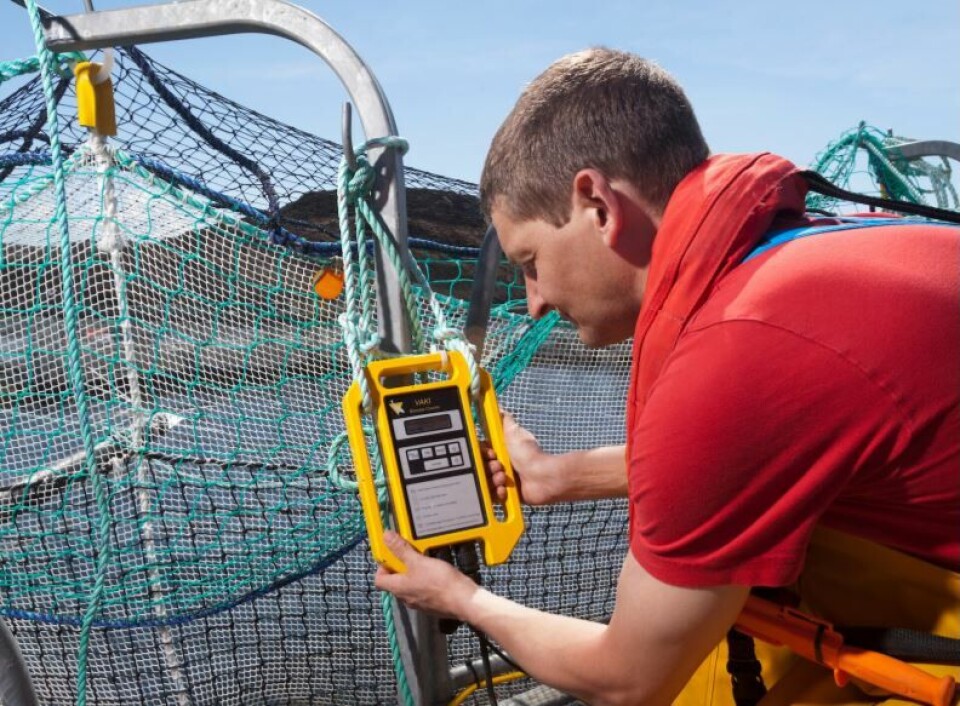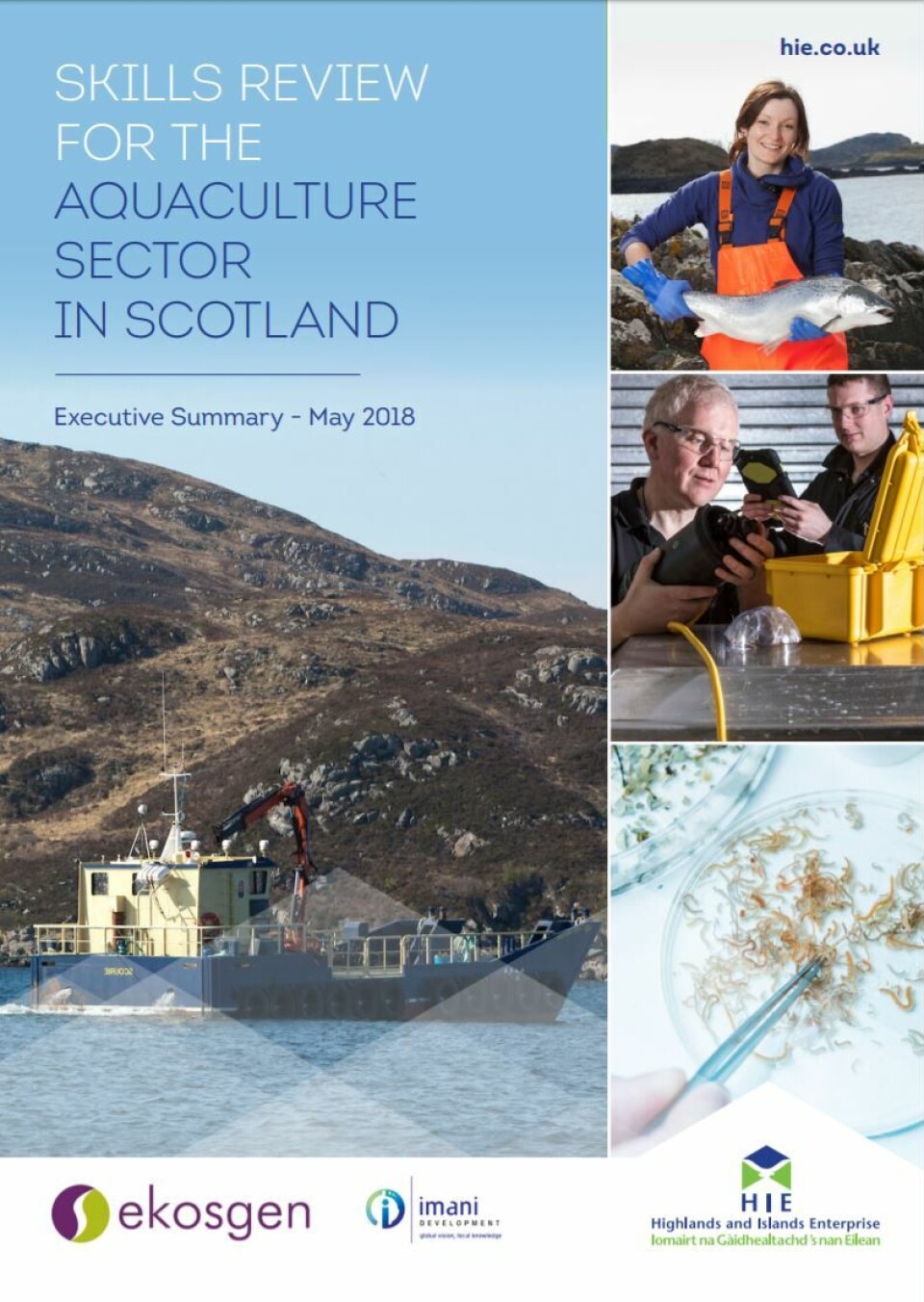
Salmon industry 'must sell itself harder and train better to attract staff'
Scotland’s salmon industry must promote itself more strongly as a career destination if it is to find the skilled workforce it will require to grow in the future, a new report states.

The industry must also look at:
- Developing leadership, management and business capacity
- Consistency and transferability of training and education
- Developing a digitally-enabled workforce
- Enhancing provision of work-based learning and vocational training
- Widening the recruitment pool by taking consideration of the factors that will attract younger people and more women
The recommendations feature in a skills review prepared by for Highlands and Islands Enterprise (HIE) by consultants Ekosgen and Imani Development, and included input from Skills Development Scotland (SDS). The review was commissioned on behalf of the Aquaculture Industry Leadership Group (AILG) in order to better understand the demand for and supply of aquaculture and related skills.
Between July 2017 and January 2018, the consultants reviewed literature and forecasting information; consulted with stakeholders and employers in the sector and the supply chain; carried out an online survey of employers; and analysed data gathered through public sources and specific data requests.
They have produced a 75-page document, Skills Review for the Aquaculture Sector in Scotland. A 12-page executive summary of the review has also been published.
Limited supply of courses
The authors highlight the fact that although Scotland’s aquaculture-related education is internationally renowned, there remains a limited supply of courses and qualifications that are specific to aquaculture.
They add that training provided by aquaculture employers is not always transferable or recognised by other employers, and that the pipeline of entrants from formal education is currently insufficient to meet demand.
They say there is a need for more vocational or practical aspects to courses, and that courses should be available in more places.
Engineering skills are a key demand and there is currently a shortage, while the availability of boat-handling training is also said to a problem.
In the supply chain, as well as boat skills and engineers, there is a demand for chemistry, environment and fish health specialists along with quality assurance during processing and value-added preparation.
Misperceptions about careers opportunities
The Review summary adds that there is a shortage in the supply of aquaculture workers generally, and in people with the right level of experience. Causes include competition from other sectors, compounded by lack of awareness and misperceptions amongst potential employees of the career opportunities in aquaculture, particularly in relation to emerging opportunities around digital and technical skills.
The locations of aquaculture operations, particularly production, also makes it difficult to attract staff. Brexit is also beginning to have an impact on the supply of much needed international workers, especially in processing.
The summary points out that there is a significant gender imbalance within the aquaculture sector workforce and education pipeline which also impacts on the available workforce.
The authors say: “There is a need to upskill and reskill the existing workforce as well as ensure the pipeline of people with the skills, attitudes and aptitudes flows into it and is retained.
“This will require a planned, strategic approach to skills development by employers, and also on the part of stakeholders in education, training and economic development.”
In the Review, the consultants point out that there is an opportunity to align with other food and drink sub-sectors in Scotland by moving the development role into the Scottish Government’s Food, Drink & Rural Communities Directorate.
More collaboration
They add: “More industry collaboration will benefit the sector through knowledge and skills transfer (i.e. trout learning from the salmon model), along with more collaboration between industry and academia for greater knowledge exchange. This would more closely align goals and outputs for the sector, ensuring Higher and Further Education Institutions are producing graduates with the skills required by industry.
“There are opportunities for the Scottish aquaculture sector to learn from other players in the sector (such as Norway for salmon and New Zealand for shellfish).
“There is also potential for knowledge sharing with sectors such as Oil and Gas in relation to technology and offshore operations. The oil and gas sector has a large number of staff in transition including Health and Safety and engineers who could bring knowledge and transferrable skills to aquaculture. These workers are used to working in remote and exposed areas and would be able to adapt to conditions on aquaculture farms.”
They add that there is also the possibility of using decommissioned oil rigs for aquaculture sites, and say that the oil and gas sector understands what a larger sector requires in terms of supply chain development and intra-sector training which will be useful in taking aquaculture to scale.
The Review adds that because of the ownership structure of a number of Scottish aquaculture producers, the flow of Norwegian innovation intellectual property presents a key learning opportunity for Scottish aquaculture in future, pointing to developments in offshore cage technology that have been granted development Norwegian licences to trial the concepts.
A downside of consolidation and vertical integration of salmon farmers is that there is a small number of large producers that supply chain companies sell in to. “This potentially limits opportunities for SMEs to enter and operate in the sector,” says the Review.
“It can also make supply chain companies vulnerable to economic shocks as a result of a narrow customer base. Sector resilience would be strengthened if there was a greater mix of business sizes and models across the aquaculture value chain. This requires a regulatory and financial landscape that supports the growth of innovative SMEs and allows new entrants and new business models.
Supply chains could suffer
“Increasing the production volume of finfish and shellfish could have significant positive consequences for Scottish innovation throughout the supply chain through creating demand, but also maintaining relatively significant volumes which would justify Scotland-specific high value research relative to other countries. If Scottish production were to drop in terms of market share, which is already happening, supply chain activities are likely to suffer, and Scotland would increasingly be a user of external innovation.”
It continues: “A considerable amount of engineering takes place in Scotland to supply farm cages, gear and some equipment; however, well boats and much R&D comes from international supply and knowledge networks. Understanding the reasons for this is essential in order to pinpoint what segments should be targeted for competitiveness and skills development, and what may be less valuable and less efficient in its benefit to the Scottish economy.”
Exploit provenance more
The Review says there is considerable opportunity to exploit the provenance of Scottish aquaculture produce and develop Scotland’s brand, but that at present Scotland’s price premium is being eroded through negative publicity based on producer’s failures to fully address environmental and fish health concerns.
“Research suggests that there is scope to further capitalise on provenance through innovation in areas such as product development, packaging, and marketing. Current marketing is done in-house by large companies, or by Seafood Scotland, Scotland Food & Drink and Scottish Development International, which are supported by the Scottish Salmon Producers Organisation (SSPO), however there is potential to do more around developing the ‘Scottish Salmon’ brand independently of the producer company to secure the value to the Scottish economy.”
Find the summary here and the full review here.























































